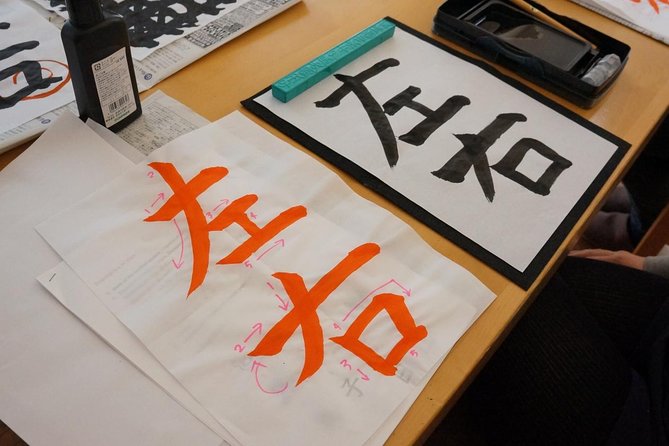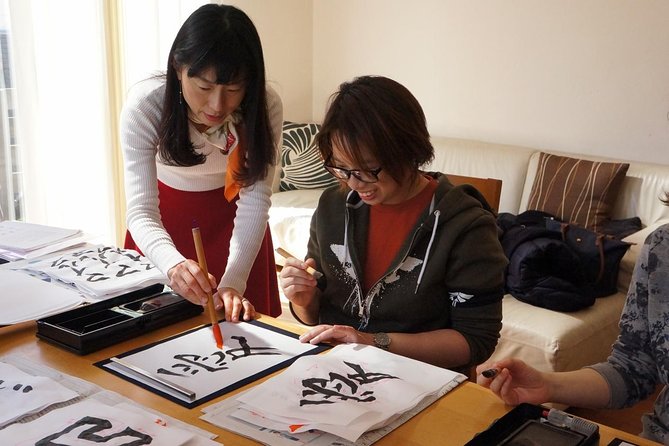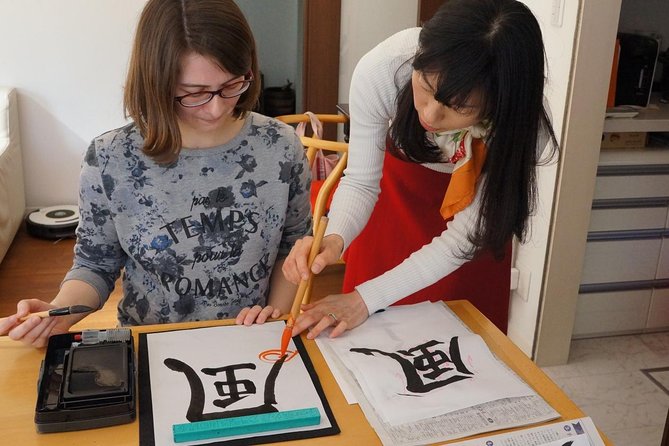Imagine stepping into a serene tatami room, guided by a seasoned calligraphy master, ready to unlock the secrets of Japanese brushwork.
As the ink flows gracefully onto the washi paper, each stroke tells a story of precision and grace.
But what makes this ancient art form so captivating?
Join the conversation to discover the hidden meanings behind each character, the meditative benefits of shodo practice, and how this exquisite craft continues to inspire generations.
Key Takeaways

- Shodo offers a creative outlet and mindfulness practice.
- Learning Shodo fosters a deep connection with Japanese culture.
- Practicing Shodo enhances appreciation for artistry and tradition.
- Exploring different techniques leads to a distinctive approach to Shodo.
What Is Shodo?

Shodo, the Japanese art of calligraphy, captivates individuals with its intricate brushstrokes and profound cultural significance. Its history dates back to ancient times when Chinese characters were introduced to Japan. Over the centuries, Shodo evolved into a respected art form that embodies harmony, discipline, and beauty.
The significance of Shodo lies not only in its aesthetic appeal but also in its ability to convey emotions, thoughts, and philosophies through carefully crafted characters. Each brushstroke carries meaning and reflects the artist’s state of mind at the moment of creation. Through practicing Shodo, individuals can connect with Japanese culture, history, and spirituality in a unique and meaningful way.
Benefits of Learning Shodo

Exploring the art of Japanese calligraphy can offer a multitude of benefits for individuals seeking to delve into a rich cultural tradition. Learning Shodo not only provides a creative outlet but also serves as a mindfulness practice, allowing practitioners to focus on each brushstroke and find inner peace through the rhythmic movements.
This ancient art form encourages a deep connection with the Japanese culture, fostering a sense of cultural appreciation and understanding. Through practicing Shodo, students can gain insights into the beauty of traditional Japanese characters and the significance behind each stroke, enhancing their appreciation for the language and artistry.
Embracing Shodo can be a fulfilling journey that combines artistic expression with mindfulness and cultural exploration.
Tools and Supplies for Shodo
When preparing for learning Japanese calligraphy, one must gather essential tools and supplies to engage in the art form effectively. Exploring creativity through Shodo requires basic items like a Fude (brush), Sumi (ink), Hanshi (paper), and Suzuri (inkstone). These tools are integral to mastering the delicate balance between control and fluidity in brushstrokes.
To delve into cultural immersion, students may also choose decorative washi papers, various colored inks, and different brush sizes to experiment with diverse styles. Understanding the significance of each tool enhances the learning experience and allows for personal expression within the traditional art form.
Techniques and Styles in Shodo
Gearing up to explore the art of Japanese calligraphy involves immersing oneself in a world of diverse techniques and styles in Shodo. When delving into Shodo, one can expect to encounter a rich tapestry of variation in strokes and styles.
From the elegant curves of Gyosho to the more structured Kaisho, each style offers a unique way to express creativity. Mastering strokes is at the heart of Shodo, where precision and fluidity come together to create beautiful characters on paper.
Practitioners often spend years honing their skills to achieve the desired balance between control and artistic flair. Exploring the nuances of different techniques can be a rewarding journey, allowing individuals to develop their own distinctive approach to this ancient art form.
Finding a Shodo Instructor
To find a Shodo instructor, start by researching local calligraphy schools or workshops in your area. Here are some tips to help you in your search:
-
Finding Inspiration: Look for instructors who’ve a strong background in Japanese calligraphy and whose work inspires you. This can help you connect with the art form on a deeper level.
-
Cultural Immersion: Consider finding an instructor who not only teaches the techniques but also provides insights into the cultural significance of Shodo. This can enrich your learning experience and broaden your understanding of Japanese traditions.
-
Personal Recommendations: Ask for recommendations from friends or online communities interested in calligraphy. Personal experiences can often lead you to the right instructor who resonates with your learning style and goals.
Preparing for Your First Shodo Lesson

As you get ready for your first Shodo lesson, consider familiarizing yourself with basic calligraphy strokes and techniques to enhance your learning experience.
| Introduction | Calligraphy Basics |
|---|---|
| Start with simple strokes like the horizontal line (Tome), vertical line (Tate), and the dot (Ten) to get comfortable with the brush. | Practice maintaining consistent pressure on the brush to achieve smooth lines. |
| Familiarize yourself with common calligraphy tools such as the Fude (brush), Sumi (ink), and Hanshi (paper) used in Shodo. | Learn about the correct posture and hand positioning to control the brush effectively. |
| Explore different styles like Kaisho (block style) and Gyosho (semi-cursive) to understand the versatility of calligraphy. | Experiment with ink shades by adjusting the water-to-ink ratio for varying line thickness. |
| Embrace the meditative aspect of Shodo by focusing on each stroke mindfully and embracing imperfections as part of the art. | Seek feedback from your instructor to improve and refine your technique throughout the lesson. |
Exploring Shodo Beyond the Basics
Delve deeper into the art of Shodo by exploring advanced brush techniques and intricate calligraphy styles to elevate your skills and creativity. Here are three ways to take your Shodo practice to the next level:
-
Mastering Advanced Strokes and Techniques: Challenge yourself with more complex brush movements like the ‘hane’ (flick), ‘harai’ (sweep), and ‘nijimi’ (bleeding) to add depth and character to your calligraphy.
-
Pushing the Boundaries of Creative Expression: Experiment with different ink shades, paper textures, and spacing to infuse your writing with personal flair and emotion, making each piece a unique reflection of your artistic vision.
-
Exploring Unique Calligraphy Styles: Study diverse calligraphy styles such as Kaisho (block style), Gyosho (semi-cursive), and Sosho (cursive) to broaden your repertoire and find the style that resonates most with your artistic sensibilities.
Frequently Asked Questions
Are There Any Age Restrictions for Participating in the Calligraphy Lesson?
Age restrictions are not mentioned, indicating that individuals of all ages are likely welcome. Attire recommendations may not be provided, but comfortable clothing is advisable for this engaging and informative calligraphy lesson.
Is There a Dress Code or Any Specific Attire Recommendations for the Lesson?
Attire recommendations for the calligraphy lesson are casual and comfortable. While there’s no strict dress code, it’s respectful to opt for traditional or modest attire out of cultural significance. Modern styles are also welcomed.
Can Participants Take Home Their Calligraphy Work or Is It for Practice Only During the Lesson?
Participants can take home their calligraphy work after the lesson. It’s not just for practice during the class. There are no age restrictions, and no specific attire recommendations were mentioned. Just bring your creativity and enjoy the experience!
Are There Any Opportunities to Purchase Additional Calligraphy Supplies or Tools After the Lesson?
Yes, participants have the option to purchase additional calligraphy supplies or tools after the lesson. They can explore various calligraphy suppliers for extra materials or equipment options to continue practicing their newfound skills at home.
Is There a Recommended Amount of Time to Practice Calligraphy Outside of the Lesson to See Improvement?
For optimal progress in calligraphy, practicing a few times a week outside lessons is recommended. The more time committed, the better the improvement. Consistent practice helps refine technique and develop skills, leading to visible growth.
Conclusion
In conclusion, Let’s Do Shodo offers a unique opportunity to explore the beauty of Japanese calligraphy in the heart of Tokyo. With a perfect 5.0 rating and glowing reviews, this immersive experience provides a blend of tradition and creativity for participants.
From personalized masterpieces to private transportation, this cultural journey promises to be a memorable and enriching adventure for all who seek to delve into the intricate world of shodo.
Book your private lesson today and unleash your artistic talents!
